Refine search
Actions for selected content:
23990 results in Ancient history
Chapter 16 - Animals
-
- Book:
- An Environmental History of Ancient Greece and Rome
- Published online:
- 05 June 2012
- Print publication:
- 08 March 2012, pp 95-97
-
- Chapter
- Export citation
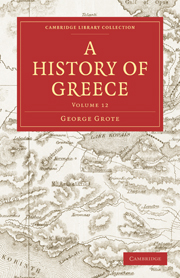
A History of Greece
-
- Published online:
- 05 March 2012
- Print publication:
- 01 April 2010
- First published in:
- 1856
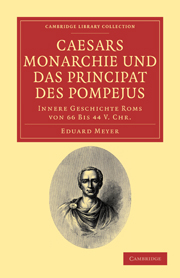
Caesars Monarchie und das Principat des Pompejus
- Innere Geschichte Roms von 66 Bis 44 V. Chr.
-
- Published online:
- 05 March 2012
- Print publication:
- 16 June 2011
- First published in:
- 1922
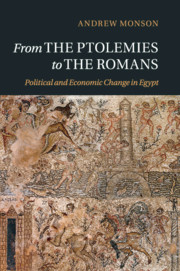
From the Ptolemies to the Romans
- Political and Economic Change in Egypt
-
- Published online:
- 05 March 2012
- Print publication:
- 02 February 2012
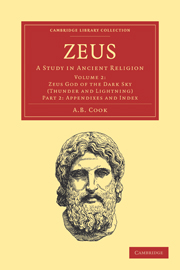
Zeus
- A Study in Ancient Religion
-
- Published online:
- 05 March 2012
- Print publication:
- 21 October 2010
- First published in:
- 1925
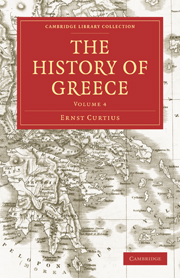
The History of Greece
-
- Published online:
- 05 March 2012
- Print publication:
- 07 July 2011
- First published in:
- 1872
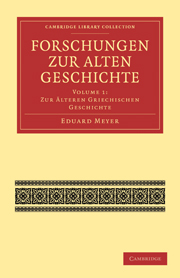
Forschungen zur Alten Geschichte
-
- Published online:
- 05 March 2012
- Print publication:
- 19 August 2010
- First published in:
- 1892
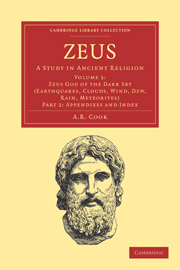
Zeus
- A Study in Ancient Religion
-
- Published online:
- 05 March 2012
- Print publication:
- 21 October 2010
- First published in:
- 1940
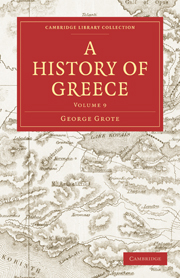
A History of Greece
-
- Published online:
- 05 March 2012
- Print publication:
- 01 April 2010
- First published in:
- 1852
13 - The First Jubilee Festival (Heb-Sed)
-
- Book:
- Amenhotep III
- Published online:
- 05 June 2012
- Print publication:
- 20 February 2012, pp 182-196
-
- Chapter
- Export citation
8 - The King's First Two Wives
-
- Book:
- Amenhotep III
- Published online:
- 05 June 2012
- Print publication:
- 20 February 2012, pp 100-109
-
- Chapter
- Export citation
7 - The Spoils of War
-
- Book:
- Amenhotep III
- Published online:
- 05 June 2012
- Print publication:
- 20 February 2012, pp 82-99
-
- Chapter
- Export citation
PROLOGUE - The Birthplace of Amenhotep III
-
- Book:
- Amenhotep III
- Published online:
- 05 June 2012
- Print publication:
- 20 February 2012, pp 16-20
-
- Chapter
- Export citation
4 - Le Roi Est Mort, Vive Le Roi!
-
- Book:
- Amenhotep III
- Published online:
- 05 June 2012
- Print publication:
- 20 February 2012, pp 51-60
-
- Chapter
- Export citation
16 - A Mixed Forecast: Dazzling Sun and Dark Clouds
-
- Book:
- Amenhotep III
- Published online:
- 05 June 2012
- Print publication:
- 20 February 2012, pp 213-224
-
- Chapter
- Export citation
1 - An Heir Unapparent
-
- Book:
- Amenhotep III
- Published online:
- 05 June 2012
- Print publication:
- 20 February 2012, pp 21-31
-
- Chapter
- Export citation
Bibliography
-
- Book:
- Amenhotep III
- Published online:
- 05 June 2012
- Print publication:
- 20 February 2012, pp 301-336
-
- Chapter
- Export citation
3 - Thutmose IV and King's Son Amenhotep in Nubia
-
- Book:
- Amenhotep III
- Published online:
- 05 June 2012
- Print publication:
- 20 February 2012, pp 42-50
-
- Chapter
- Export citation
Index
-
- Book:
- Amenhotep III
- Published online:
- 05 June 2012
- Print publication:
- 20 February 2012, pp 337-351
-
- Chapter
- Export citation
EPILOGUE - One God Left Standing
-
- Book:
- Amenhotep III
- Published online:
- 05 June 2012
- Print publication:
- 20 February 2012, pp 255-256
-
- Chapter
- Export citation
